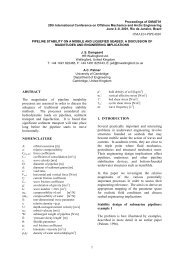Cantilever-like micromechanical sensors - Artek
Cantilever-like micromechanical sensors - Artek
Cantilever-like micromechanical sensors - Artek
Create successful ePaper yourself
Turn your PDF publications into a flip-book with our unique Google optimized e-Paper software.
Rep. Prog. Phys. 74 (2011) 036101 A Boisen et al<br />
such as silicon nitride or polymers where an inhomogeneous<br />
electric field produces a net force (Kelvin polarization force)<br />
acting on a dielectric micro- or nano-beam [128, 218–220].<br />
In thermal actuation a bimorph cantilever is heated in a<br />
pulsed manner using for example an integrated resistive heater<br />
[221] or an external laser [222]. Also, natural thermal<br />
vibrations due to fluctuations in the temperature of the structure<br />
can be used [223]. In magnetomotive actuation a static<br />
magnetic field is applied perpendicular to a cantilever through<br />
which an alternating current is running. The Lorentz forces<br />
will thereby cause the cantilever to deflect. The method<br />
requires large magnetic fields and low temperatures and has<br />
recently been used in mass detection using nanometre-sized<br />
cantilevers [224].<br />
5. Applications<br />
Examples of biomolecule detection have recently been<br />
presented in review papers [2, 7, 225] where levels of<br />
detections have also been compared. Also, the use of<br />
cantilever-based <strong>sensors</strong> in explosives detection has recently<br />
been discussed in a broader context [226]. Here some of<br />
the major research areas within cantilever applications will<br />
be described.<br />
5.1. Surface functionalization<br />
In order for a cantilever-based sensor to be able to detect<br />
specific molecules it needs to be coated with specific ‘detector’<br />
molecules. For surface stress measurements it is important<br />
that only one side of the cantilever is coated since a uniform<br />
generation of surface stress on both cantilever sides will<br />
not result in a cantilever deflection. For mass sensing<br />
both sides can be functionalized although for maximum<br />
sensitivity it might be beneficial to have only the end of the<br />
cantilever functionalized. For all functionalization strategies<br />
the blocking of all other surfaces is crucial in order to prevent<br />
unspecific binding.<br />
In order to selectively coat closely spaced cantilevers<br />
several different technologies have been developed. A<br />
common and widely used technology is to first coat the<br />
cantilevers with a thin gold layer on one side and then later use<br />
thiol-based chemistry to bind the probe molecules strongly to<br />
the gold surface. Within the cantilever community it is known<br />
that the quality of the evaporated gold has a high influence on<br />
the size and signature of the generated signals, as discussed<br />
in section 2.2.2. Great care has to be taken in preparing clean<br />
surfaces and also the crystallinity seems to have an effect on<br />
the signals. For silicon surfaces, silane coupling chemistry is<br />
often used and for polymer cantilevers new methods have been<br />
developed which, for example, use the epoxy groups on the<br />
surface of SU-8 [227]. Also, photo-activated chemistry which<br />
reacts with C–H bonds in polymers [143] has been utilized.<br />
To expose different cantilevers in an array to different<br />
liquids one can apply microspotting using technologies<br />
developed for the realization of DNA arrays [228, 229].<br />
Alternatively, capillaries placed with a spacing corresponding<br />
to the cantilever spacing are used as small beakers in which<br />
the cantilevers are inserted [90].<br />
19<br />
5.2. Bacteria detection<br />
Whole bacteria or segments of bacteria can be caught directly<br />
on a cantilever. For example, if a cantilever is coated with<br />
antibodies against E.coli the cantilever will specifically bind<br />
to E.coli. The sensor might be expanded to contain several<br />
cantilevers each coated with a specific antibody. In this way<br />
it is possible to detect multiple bacteria simultaneously. One<br />
of the first groups to demonstrate bacteria detection was the<br />
group of Craighead et al which, in 2001, showed the mass<br />
detection of E.coli bacteria [223]. As more bacteria were<br />
bound to a cantilever the resonant frequency was seen to change<br />
correspondingly. Later the detection of Salmonella enterica<br />
was reported—in this case monitoring the change in surface<br />
stress upon binding of bacteria [230].<br />
More fundamental studies have illustrated the influence of<br />
bacteria position on the generated mass signal [231, 232]. By<br />
analysing the resonant frequency shift for bacteria positioned<br />
at different positions along the cantilever and by operating the<br />
cantilever at different modes it was found that the mass signal<br />
depends on both the added mass and on the resulting change<br />
in stiffness of the cantilever as seen from equation (2.10).<br />
When a bacterium adsorbs on regions of high vibrational<br />
amplitude the resonant frequency change will be dominated<br />
by the mass changes. When the bacterium is positioned<br />
at a nodal point or at the clamped region the measured<br />
frequency response is governed by the change in stiffness. The<br />
addition of mass will thus result in an increase in the resonant<br />
frequency. These results highlight the necessity of controlling<br />
the position of bacteria absorption and show that either the<br />
stiffness effect or the mass change can be used for sensing<br />
purposes.<br />
The growth of E.coli has been studied by coating<br />
cantilevers with a nutrient layer and monitoring the change in<br />
resonant frequency continuously [233] astheE.coli bacteria<br />
placed on top of the nutrient layer are growing. The resulting<br />
data show that it is possible to detect active bacterial growth in<br />
less than 1 h. Using rather large piezoelectric cantilevers made<br />
of PZT and glass (5 and 3 mm in length, 1.8 and 2.0 mm wide)<br />
the possibility of distinguishing between pathogen and nonpathogen<br />
E.coli was demonstrated [234]. The cantilever was<br />
coated with antibodies against pathogen E.coli and immersed<br />
in a mixed population of both pathogenic and non-pathogenic<br />
strains. The cantilever was seen to be highly selective only<br />
binding the pathogen species.<br />
A highly sophisticated system for single cell detection<br />
has been developed by Manalis et al. Normally, resonators<br />
are damped when operated in liquid, thus lowering the<br />
sensitivity significantly. Manalis et al have removed this<br />
obstacle by flowing liquid inside the cantilever. Thereby, the<br />
device can be operated in a vacuum while analysing liquids<br />
inside the cantilever structure [235]. The first experiments<br />
focused on the demonstration of the detection of avidin<br />
binding. This was done by flushing the inner channel walls<br />
with biotinylated bovine serum albumin and subsequently<br />
monitoring the resulting resonant frequency shift as avidin is<br />
flushed through the system and binds to the functionalized<br />
walls. Single E.coli cell detection was demonstrated in<br />
2007 [236]. Here a buffer solution containing E.coli is run





